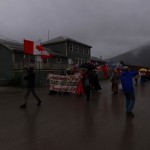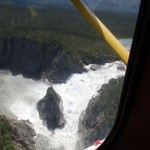6/30 – 7/1

Downtown Dawson City
Dawson City still has that frontier town feel to it: many of the original buildings are still standing, although some at rather strange angles because of permafrost melting and the sidewalks are wooden boardwalks. With the exception of Front street the roads are dirt; the reason for this is that with the constant frost heaves, in the fall and spring, it is much, much cheaper to fix dirt roads than asphalt ones.

Yukon Commissioner’s Residence – restored
Quite a few of the buildings have been taken over by Parks Canada and restored. Each has a docent, dressed in period costumes, to explain the history and architecture. The docents really get into their characters and it is evident they relish their act, they make the history come alive.
Of special note is the Danoja Zho Cultural Center which is run by the Tr’ondëk Hwëch’in First Nation people and explains their history and culture. Our tour was led by the great, great, great nephew of Chief Isaac who, in the late 1800’s and early 1900’s mediated between the Tr’ondëk Hwëch’in and the incoming gold rushers; he was a bridge between the old ways and the new and assured that his people gained respect and full rights within the Canadian government. It is because of Chief Isaac that the Tr’ondëk Hwëch’in have an absolute say in the stewardship of their lands.

Canada Day Parade
We had planed to stay in Dawson for two days, to visit all the sights, but Canada Day, which celebrates Canada’s achievement of Commonwealth status with England, is July 1st and we thought it would be fun to join in the festivities. Also, the weather was rainy with very low clouds and driving the Top Of The World Highway, which is a dirt road with hairpin turns and steep drop-offs, would not be all that much fun.
More Dawson City Photos
← older posts newer posts →






































